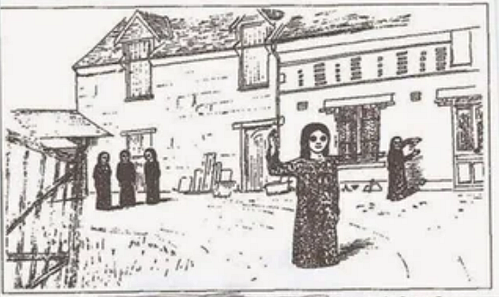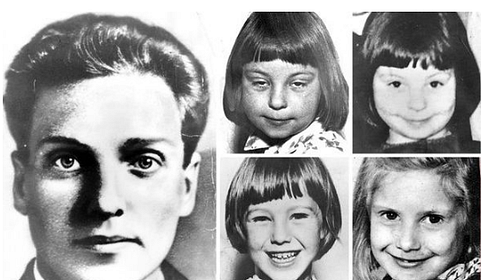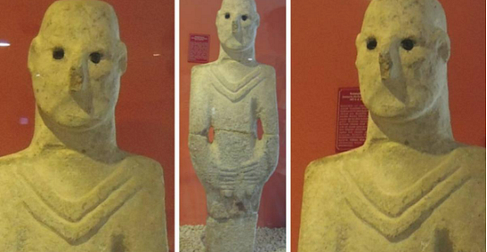Entering the Halloween Season: Beware the Pleas of the Black-Eyed Kids

Image from Morbidly Beautiful
‘Tis the season to unlock a modern urban legend as unsettling as it is mysterious: the Black-Eyed Kids, often called BEKs. Who are they? What do they want? And why do so many people claim to have seen them? Grab a flashlight — and maybe lock your door — because as the lore goes, they come once you talk or think about them.
Before viral videos and Reddit threads, a single account planted the seed for a story that would spread worldwide. In 1996, Brian Bethel, then a reporter for the Abilene Reporter News, finished a late shift and pulled into a dim strip-mall parking lot to write a check. As he sat in his car, filling out the check, an instinctive awareness washed over him: the hair on the back of his neck rose, and he felt watched. Two boys, roughly ten to fourteen years old, stood outside his driver’s side window. At first, they seemed ordinary, wearing hoodies, but unnervingly close to the car, and their behavior and speech were wrong. They told him they wanted a ride home and had come to see Mortal Kombat but had no money; the theater listings showed the movie had started more than forty-five minutes earlier. Their voices were older than their faces, too articulate and confident, as if adults were pretending to be children.

When Brian asked where they lived, their tone hardened. “Just let us in. We won’t take long,” one of them said, shifting from request to command. As dread pooled in his chest, Brian finally met their gaze. He saw something impossible: no sclera, iris, or pupil… only black. He felt frozen for a moment, and then instinct took over. He threw the car into reverse and sped away. Seconds later, the boys were gone; they hadn’t been seen running or walking away. They simply vanished.
Back in his apartment, he locked every door and window and wrote the experience down to make sense of it. An email he sent to friends describing the event leaked and was posted on an online message board (before it was popular to do so), and finally, it was published in an article for his own paper. The story ignited the modern Black-Eyed Kids myth. It spread through paranormal forums, late-night radio, and digital campfires worldwide.
Years later, when investigative journalist Ryan Sprague interviewed him around 2015, Brian said the encounter had dramatically disturbed his sleep. “I didn’t want to sleep at all, actually. I felt unsafe doing so. I kept fantasizing about them appearing at the foot of my bed or waiting outside my door when I went outside. It was a rough few weeks, I’ll say, and the effects linger to this day,” he recalled. He admitted that the image of black eyes still triggers panic and that he’d “legitimately did not know if [he] was going to die or not.” Asked about the possibility that his account helped launch an urban legend, Brian acknowledged how easy it is to shape a convincing story from a single, evocative scenario: kids knocking on a car window, a door opening, a terrible revelation. He said he judged each story on its merits and applied greater skepticism to anything that slavishly followed that basic formula. However, he also insisted he’d heard many accounts he believed were true.
Scholars and urban-legend researchers often point to Brian’s account as the modern birth of the BEK myth. While details vary from encounter to encounter, a persistent theory has emerged: these beings are death personified as children. They weaponize our instincts, our trust in innocence and empathy for the helpless, and turn them against us. Once invited in, the theory goes, they do more than cause immediate harm; they bring ruin, illness, and even death.

Across decades and continents, reports of BEKs share a set of recurring, uncanny details that read like pieces of the same dark script. Witnesses always describe the beings as children or teens, which is the trick: the figure of a child triggers our impulse to protect and help. Their clothing is often slightly off — thrift-store layers, outdated styles, or odd logos from defunct teams — small mistakes that suggest they are mimicking human dress but missing the mark. They appear in liminal places: on doorsteps, along dark roads, in strip-mall parking lots, and at remote cabins where boundaries between safety and isolation are thin. Their speech is frequently monotone, oddly formal, or far more mature than their faces would suggest, and witnesses often report repetition; a phrase delivered like a broken loop. The horror comes in stages: a polite plea to use the phone, the bathroom, or to be given a ride, a stall, or refusal from the human, then a shift in demeanor toward insistence, even hostility.
And then there are the eyes. Jason Offutt, a journalist and long-time researcher into these accounts, has described them as rat-like: shiny, flat, empty. Witnesses say there is no white, iris, or pupil, only black. That moment of direct gaze triggers a primal terror. This physical jolt feels like the body understands the wrongness before the conscious mind does. Crucially, the folklore insists that the children cannot enter unless invited. That tiny, symbolic threshold (spoken aloud or implied) ties the legend to ancient stories of vampires, demons, and fae who require consent to cross into human space. Once that invitation is granted, stories often link the decision to misfortune like a fatal car crash within days, sudden diagnoses of terminal illness, pets that vanish, and lives that unravel.
Many researchers trace the BEK archetype back to older myths. The Irish changeling, for example, bears an uncomfortable resemblance. In Celtic tales, the fair folk sometimes stole human babies and left changelings in their place; children who seemed right initially but were wrong in small, telltale ways. Parents noticed the impostors because they were unnaturally quiet or disastrously precocious, sometimes speaking too early or knowing things they should not. The changeling’s eyes were often described as cold or hollow, and folklore prescribed remedies of iron or fire to drive the creature out… remedies born of desperation and fear. The parallels are obvious. The changeling and the Black-Eyed Kid are present as children, both ask to be taken in, and leave a wake of dread.

The modern myth accumulates stories from across time and place. A striking case from 2015 tells of a married couple who rented a remote cabin in snowy Vermont only to be awakened by a loud knock late at night. Two children stood on the porch, asking politely to use the phone. Despite an overwhelming sense of unease, the couple let them inside. The power immediately went out. Their dog bolted and hid under the bed. The children sat motionless on the couch, their eyes fixed and blank, never blinking. Minutes later, one stood and said, “Our parents are here.” They walked out into the snow without coats and disappeared toward two tall, shadowy figures at the tree line. Within weeks, the husband developed an aggressive form of skin cancer while the wife suffered severe migraines and unexplained nosebleeds. The couple believed the night they let those children in was the night everything changed.
On the internet, stories proliferate. A U.S. Marine stationed at Camp Lejeune posted an account on Reddit in 2012 about an incident from November 2009. He had stayed behind at the barracks for the weekend and was relaxing alone when someone knocked on his third-floor walkway door. Expecting a roommate, he opened the door to find two children standing in the corridor. Their eyes were pitch black. They said they were cold and wanted to come in to read. The Marine hesitated; their tone was flat and calm, and no one on a Marine base would plausibly ask to read at midnight. When he looked back, they had taken a step closer. Every instinct screamed that something was wrong, so he shut and locked the door. There was a steady knocking for the next five minutes and the sound of his window rattling; then silence. The next morning, there were no reports of missing children or a logical explanation. He said it was not fear like he had felt in combat, but a different kind of fear that made him listen.
Long before message boards and YouTube, older accounts echo the modern BEK motif. In a rural American town in the 1950s, a teenager named Harold walked past a fence where a child leaned, unresponsive to a greeting. The child whispered, “I wanna go to your house. Take me to your house.” When Harold didn’t move, the child revealed solid black eyes and screamed, “Now don’t you run away from me. You’re gonna walk me to your house.” Harold fled, and the scream that followed was later mistaken by his mother for a bobcat; she had him blessed by clergy, convinced he had seen the devil.
In 1974, two men driving through a village in Aisne, France, saw five small figures near the village’s last house. The figures had long hair down their backs, compressed noses, and shut mouths; one approached the car and was described as just over four feet tall, wearing a long spotted robe with earthy yellow skin and billiard-ball-sized black eyes. The sighting terrified the men; the figures were gone when they returned with locals. However, one resident insisted he had seen “children in yellow raincoats.”

The legend persists in England’s Cannock Chase and is soaked in tragedy and lore. In 2014, paranormal investigator Lee Brickley documented a woman and her daughter who heard a scream and found a girl of about ten covering her face. When the mother asked if she was okay, the child lowered her hands to reveal pitch-black eyes and vanished. Brickley’s aunt had reported a similar sighting in 1982. Some speculate the black-eyed child in Cannock Chase is connected to the area’s real-life tragedies from the late 1960s, when the bodies of three young girls were found around the Chase; one man, Raymond Morris, was convicted for one of the killings. Whether ghost, spirit, or something else, the sightings seem to replay the area’s history of grief.

Research like David Weatherly’s catalogs even earlier stories that resonate with the BEK pattern. Weatherly uncovered tales from ancient China of a black-eyed girl who haunted villages after a wrongful death and allegedly triggered plagues and natural disasters. He found parallels in Japanese folklore of demonic children with empty black eyes who steal souls or spread misfortune. These images have filtered into modern horror films. He even draws a line — more poetic than scientific — to the Urfa Man, a 13,500-year-old statue from Göbekli Tepe whose eyes were once inlaid with polished obsidian; visitors describe a chilling presence near the statue, a sense of being watched that echoes the same discomfort BEK witnesses report.

What ties these accounts together? In each tale — from the Marine and Alain to the Vermont couple and Brian Bethel — one thing is consistent: they want in. Whether into a car, a house, or some whisper, the soul itself, the BEKs appear to covet what humans most protect. Some theorize they feed on fear. Others suggest they can read minds and adapt their behavior to manipulate or intimidate. Labels abound: demons, interdimensional parasites, extraterrestrial observers. Perhaps the scariest idea is spiritual rather than physical. Whatever these entities are, they might be after something more profound than flesh. Brian Bethel put it in the interviews following his encounter:
“They are dangerous entities, to be sure. But we have something they don’t. Something they desperately want… the human soul. And they can’t take it — unless we let them.”
Why do these stories terrify us so profoundly? Partly because of the uncanny valley. The sensation when something looks almost human but is not quite right. Our brains notice the slight deviations and interpret them as danger. The image of corrupted innocence is a convenient horror trope; children turned malevolent have been part of nightmare stories for decades in films like The Omen, Children of the Corn, The Ring, and even Pet Sematary. There’s also a symbolic terror at play: the simple act of opening your door, of letting something into your home or your life, carries immense risk if you misjudge who… or what is on the other side. That moment of hesitation, that tiny behavioral fault-line, is all the BEKs need.
The legend has threaded itself into pop culture. BEKs have become a staple of indie horror, short films, and online storytelling. They appear in dramatized television series such as Paranormal Witness and Monsters and Mysteries in America, where reenactments blur the line between testimony and fiction. Independent games force players to navigate eerie towns and avoid emotionless children whose eyes do not blink. Films and shorts inspired by the myth include The Black-Eyed Children (2009), The Black-Eyed Children by Mat Matzen (2011), Sunshine Girl and the Hunt for Black Eyed Kids (Anna Millard, 2012), The Artifice (Matthew Holmes, 2014), and Black-Eyed Children: Let Me In (Justin Snyder, 2015). The BEKs also appear in literary collections like David Weatherly’s book The Black-Eyed Children, which gathers firsthand accounts, folklore links, and psychological theories. And they star in comics such as the 2016 Black-Eyed Kids series from Aftershock Comics, written by Joe Pruett with art by Szymon Kudranski, which imagines them as part of a larger, organized force. The legend thrives on social platforms like TikTok and YouTube, with story-time creators adding whispered narration, eerie filters, and unsettling music to keep the phenomenon alive and viral.
That virality raises a philosophical question: are Black-Eyed Kids “real” in the empirical sense, or are they egregores: thoughtforms powered into existence by collective belief and retelling? The more we talk about them, parse the details, and dramatize the encounters, the more vivid and persistent they become. Could the very act of naming and sharing summon them in some cultural sense? Or do these stories reflect more profound psychological and cultural anxieties that civilization replays in a modern, digital myth?
Whatever your stance, the BEK legend is a warning couched in folklore and late-night fear: not everything that knocks deserves to be let in. Suppose you have an encounter, a theory, or a piece of evidence. In that case, the storytellers and researchers who follow this myth want to hear it. Drop a comment below, share your experience, and keep the conversation going.
Black-Eyed Kids are not merely internet campfire stories; they are warnings about boundaries and the thinness of safety. They remind us that innocence can be mimicked and that the slightest misstep, like opening the door, offering a ride, or granting permission, can have consequences we cannot foresee. So, if you’re reading this at night, keep your lights on, lock your doors, and whatever you do, do not open the door.
Listen to The Ominous Archives to learn more about BEKs!
References
Atlas Obscura. (n.d.). Death as a child: The modern legend of the black-eyed children. Atlas Obscura. https://www.atlasobscura.com/articles/black-eyed-children-urban-legend
Before It’s News. (2014, July). The little strangers from Aisne, France. https://beforeitsnews.com/paranormal/2014/07/the-little-strangers-from-aisne-france-2472962.html
Escalas Ruiz, M. (n.d.). Is YouTube a new digital sphere for urban legends? The representation of disturbing childhood through the Black-Eyed-Kids (BEKs) cultural phenomenon. ResearchGate. https://www.researchgate.net/
GBPA (The Ghostly Portal of the Appalachian). (n.d.). Black-eyed kids. The GBPA. https://www.thegbpa.com/black-eyed-kids.html
Harold, J. (n.d.). Can we come in? — The lore of the black eyed children — Ryan Sprague’s Hidden Auditorium. Jim Harold. https://jimharold.com/can-we-come-in-the-lore-of-the-black-eyed-children-ryan-spragues-hidden-auditorium/
LiveAbout. (n.d.). Paranormal stories: The marine and the black-eyed kids. LiveAbout. https://www.liveabout.com/marine-and-the-black-eyed-kids-2593735
Monstrum / PBS. (n.d.). Don’t let them in! The urban legends of black-eyed children. ALL ARTS. https://www.allarts.org/programs/monstrum/dont-let-them-in-the-urban-legends-of-black-eyed-children-oht8de/
Scare Chamber. (n.d.). Black-eyed children. The Scare Chamber. https://www.thescarechamber.com/black-eyed-children
Unexplained.ie. (n.d.). Cannock Chase black eyed children legend lives on after latest sighting. Unexplained.ie. https://www.unexplained.ie/article/1198-cannock-chase-black-eyed-children-legend-lives-on-after-latest-sighting/

Dive into the chilling world of horror literature and explore spine-tingling tales crafted by Samantha Almeida. Follow me on social media for the latest updates, exclusive content, and a community of fellow horror enthusiasts. Remember, the shadows are always watching—stay connected and keep the scares alive!
Home | About | Services | Privacy Policy
